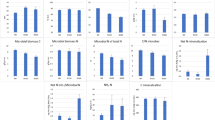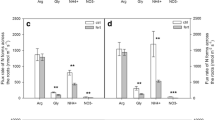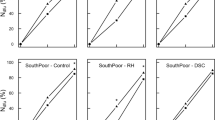Abstract
Three-year-old Scots pine (Pinus sylvestris) trees were grown on a sandy forest soil in pots, with the objective to determine their NH4/NO3 uptake ratio and proton efflux. N was supplied in three NH4-N/NO3-N ratios, 3:1, 1:1 and 1:3, either as 15NH4+14NO3 or as 14NH4+15NO3. Total N and 15N acquisition of different plant parts were measured. Averaged over the whole tree, the NH4/NO3 uptake ratios throughout the growing season were found to be 4.2, 2.5, and 1.5 for the three application ratios, respectively. The excess cation-over-anion uptake value (Ca-Aa) appeared to be linearly related to the natural logarithm of the NH4/NO3 uptake ratio. Further, this uptake ratio was related to the NH4/NO3 ratio of the soil solution. From these relationship it was estimated that Scots pine exhibits an acidifying uptake pattern as long as the contribution of nitrate to the N nutrition is lower than 70%. Under field circumstances root uptake may cause soil acidification in the topsoil, containing the largest part of the root system, and soil alkalization in deeper soil layers.
Similar content being viewed by others
References
Adams M A and Attiwill P M 1982 Nitrate reductase activity and growth response of forest species to ammonium and nitrate sources of nitrogen. Plant and Soil 66, 373–381.
Arnold G and VanDiest A 1991 Nitrogen supply, tree growth and soil acidification. Fert. Res. 27, 29–38.
Bigg W L and Daniel T W 1978 Effects of nitrate, ammonium and pH on the growth of conifer seedlings and their production of nitrate reductase. Plant and Soil 50, 371–385.
Bledsoe C S and Zasoski R J 1983 Effects of ammonium and nitrate on growth and nitrogen uptake by mycorrhizal Douglas-fir seedlings. Plant and Soil 71, 445–454.
Boxman A D and Roelofs J G M 1988 Some effects of nitrate versus ammonium nutrition on the nutrient fluxes in Pinus sylvestris seedlings. Effects of mycorrhizal infection. Can. J. Bot. 66, 1091–1097.
Clarkson D T and Warner A J 1979 Relationship between root temperature and the transport of ammonium and nitrate ions by Italian and perennial ryegrass (Lolium multiflorum and Lolium perenne) Plant Physiol. 64, 557–561.
De Boer W 1989 Nitrification in Dutch Heathland Soils. Ph.D. thesis, Wageningen Agricultural University. 96 p.
De Visser P H B 1991 Manipulation of the water and nutrient supply in two forest ecosystems in the Netherlands that are exposed to acid atmospheric deposition. Dutch Priority Programme on Acidification, report no. 100.1.
Evers F H 1963 Effect of ammonium and nitrate nitrogen on growth and mineral content of Picea and Populus. I. Growth at different acidity levels and Ca concentration in the nutrient medium. Z. Bot. 51, 61–79.
Gijsman A 1990a Nitrogen Nutrition and Rhizosphere pH of Douglas-fir. Ph.D. thesis, State University Groningen. 136 p.
Gijsman A 1990b Nitrogen nutrition of Douglas-fir (Pseudotsuga menziesii) on strongly acid sandy soil. I. Growth, nutrient uptake and ionic balance. Plant and Soil 126, 53–61.
Gijsman A 1991 Soil water content as a key factor determining the source of nitrogen (NH4 + or NO3 -) absorbed by Douglas-fir (Pseudotsuga menziesii) and the pattern of rhizosphere pH along its roots. Can. J. For. Res. 21, 616–625.
Hageman R H 1984 Ammonium versus nitrate nutrition of higher plants. In Nitrogen in Crop Production. Ed. R DHauck. pp 67–85. ASA-CSSA-SSSA, Madison, WI.
Houba V J G, Novozamsky I, Lexmond Th M and Van derLee J J 1990. Applicability of 0.01 M CaCl2 as a single extraction solution for the assessment of the nutrient status of soils and other diagnostic purposes. Comm. Soil Sci. Plant Anat. 21, 2281–2290.
Keltjens W G and VanLoenen E 1989 Effects of aluminium on growth and nutritional composition of hydroponically grown seedlings of five different forest tree species. Plant and Soil 119, 39–50.
Lehnardt F and Brechtel H M 1980 Durchwurzelungs- und Schöpftiefen von Waldbeständen verschiedener Baumarten und Altersklassen bei unterschiedlichen Standortsverhältnissen. Teil I: Erfahrungen aus Geländearbeiten und Ergebnisse veröffentlichter Untersuchungen. Allg. Forst-u. Jagdz. 151, 120–127.
Marschner H, Häussling M and George E 1991 Ammonium and nitrate uptake rates and rhizosphere pH in nonmycorrhizal roots of Norway spruce [Picea abies (L.) Karst.]. Trees 5, 14–21.
Mengel K and Kirkby E A 1987 Principles of Plant Nutrition. International Potash Institute, Bern, Switzerland. 678 p.
Nelson L E and Selby R 1974 The effect of nitrogen sources and iron levels on the growth and composition of Sitka Spruce and Scots Pine. Plant and Soil 41, 573–588.
Persson H. 1988. Root growth and root processes-effects of air pollutants in forest stands. In Relationships between Above and Below Ground Influences of Air Pollutants on Forest Trees. Eds. J Bervaes, P Mathy and P Evers. pp 180–186. Proceedings, Commission of the European Communities and ‘De Dorschkamp’, Wageningen, Gennep, December 1987.
Raven J A 1986 Biochemical disposal of excess H in growing plants? New Phytol. 104, 175–206.
SAS Institute Inc. 1988 SAS/STAT User's Guide. Release 6.03 edition. SAS Institute Inc., Cary, NC.
Stams A J M, Lutke Schipholt I J, Marnette E C L, Beemsterboer B and Woittiez J R W 1990 Conversion of 15N-ammonium in forest soils. Plant and Soil 125, 129–134.
Tiktak A, Konsten C J M, Van der Maas R and Bouten W 1988 Soil chemistry and physics of two Douglas-fir stands affected by acid atmospheric deposition on the Veluwe, Netherlands. Dutch Priority Programme on Acidification, report no. 03–01.
Troelstra S R 1983 growth of Plantago lanceolota and Plantago major on a NO3/NH4 medium and the estimation of the utilization of nitrate and ammonium from ionic-balance aspects. Plant and Soil 70, 183–197.
Ulrich B 1986 Natural and anthropogenic components of soil acidification. Z. Pflanzenernaehr. Bodenkd. 149, 702–717.
Vonk J W, Barug D and Bosma T N P 1988 Fate of mineral nitrogen in acid heathland and forest soils. In Air Pollution and Ecosystems. Ed. P Mathy. pp 835–840. Proceedings, Commission of the European Communities, Grenoble, May 1987.
VanBreemen N, Mulder J and VanGrinsven J J M 1987 Impacts of acid atmospheric deposition on woodland soils in the Netherlands. II. Nitrogen transformations. Soil Sci. Soc. Am. J. 51, 1634–1640.
Van den Burg 1979 De zwavelvoorziening en zwavel-stikstofrelatic van enige houtsoorten. Research Institute for Forestry and Urban Ecology ‘De Dorschkamp’, report no. 193.
Van denDriessche R and Dangerfield J 1975 Response of Douglas fir seedlings to nitrate and ammounium nitrogen sources under various environmental conditions. Plant and Soil 42, 685–702.
VanDiest A 1989 Eintrag von NO3 und NH4 in niederländische Waldbestände und deren Auswirkungen auf die N-Ernährung und den Vitalitätszustand. Kali-Briefe (Büntehof) 19, 391–401.
Author information
Authors and Affiliations
Rights and permissions
About this article
Cite this article
Arnold, G. Soil acidification as caused by the nitrogen uptake pattern of Scots pine (Pinus sylvestris). Plant Soil 142, 41–51 (1992). https://doi.org/10.1007/BF00010173
Received:
Issue Date:
DOI: https://doi.org/10.1007/BF00010173




